Ophiuchus, often referred to as the “Serpent Bearer,” is an intriguing constellation that has captivated artists throughout history. Its presence in art and visual representations has served as a source of inspiration and fascination, weaving its way into various mythologies, ancient artworks, and contemporary interpretations. From ancient depictions in mythology and art to Renaissance masterpieces and modern digital creations, Ophiuchus has left an indelible mark on the artistic world. In this article, we will explore the role of Ophiuchus in art, tracing its evolution and symbolism in different art forms and discussing its significance in the realms of healing, wisdom, and transformation. Join us on this journey through time and art as we uncover the mysteries and beauty of Ophiuchus.
Contents
- Ancient Representations of Ophiuchus
- Ophiuchus in Renaissance Art
- Modern Interpretations of Ophiuchus
- The Symbolism of Ophiuchus in Art
- Conclusion
-
Frequently Asked Questions
- 1. What is the significance of Ophiuchus in mythology?
- 2. How does Ophiuchus feature in ancient art?
- 3. Is Ophiuchus present in Renaissance art?
- 4. How does Ophiuchus feature in contemporary art?
- 5. What role does Ophiuchus play in digital art?
- 6. What is the symbolism behind Ophiuchus in art?
- 7. How does Ophiuchus symbolize healing and medicine?
- 8. Why is Ophiuchus associated with wisdom and knowledge?
- 9. How does Ophiuchus represent transformation and renewal in art?
- 10. What is the overall impact of Ophiuchus in art history?
- References
-
Frequently Asked Questions
- 1. Who is Ophiuchus in mythology?
- 2. What is the significance of Ophiuchus in astrology?
- 3. How did Ophiuchus influence ancient art?
- 4. What are some famous artistic representations of Ophiuchus?
- 5. How does Ophiuchus appear in Renaissance art?
- 6. What is the symbolism behind Ophiuchus in contemporary art?
- 7. How is Ophiuchus portrayed in digital art?
- 8. What does the serpent represent in Ophiuchus art?
- 9. What emotions or ideas does Ophiuchus art evoke?
- 10. Is Ophiuchus recognized in all art forms?
- References
- Read More
Ancient Representations of Ophiuchus
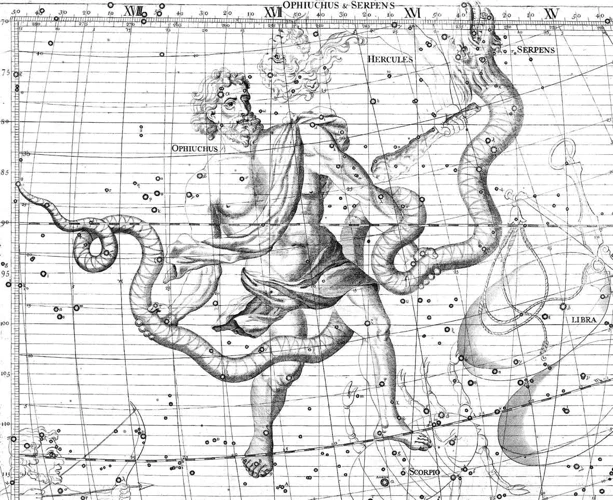
In ancient times, Ophiuchus held a significant place in various cultures, leaving its mark on mythology and art from around the world. One intriguing aspect of Ophiuchus is its presence in different mythologies, notably in Greek mythology where it is associated with the legendary figure of Asclepius, the god of healing and medicine. The symbol of a serpent wrapped around a staff, known as the Rod of Asclepius, is often associated with Ophiuchus. This symbol, representing healing and rejuvenation, has been depicted in ancient art forms, including pottery, mosaics, and sculptures. Ophiuchus’ connection to healing also transcends cultures, with similar serpent motifs found in Aztec mythology and other ancient civilizations. The significance of Ophiuchus in ancient representations cannot be understated, as it symbolized the power of medicine and the belief in the restoration of health and well-being. To learn more about ancient constellations, click here.
1. Ophiuchus in Mythology
In mythology, Ophiuchus plays a prominent role, particularly in Greek mythology where it is linked to the god Asclepius. Asclepius, the god of healing and medicine, is often associated with the constellation Ophiuchus. According to the myth, Asclepius possessed great healing powers and was known for his ability to revive the dead. In one story, Asclepius used his knowledge of herbs and medicine to bring a dead person back to life, angering Hades, the god of the underworld. As punishment, Zeus struck Asclepius with a lightning bolt, killing him. To honor his contributions to healing, Zeus placed Asclepius among the stars, resulting in the constellation Ophiuchus. This constellation is often depicted as a man holding a serpent, representing the wisdom and power of the god of medicine. The influence of Ophiuchus in mythology extends beyond Greek mythology, with similar serpent motifs found in other cultures such as Aztec mythology. To learn more about astrology and compatible zodiac signs, check out our article on Aries and Leo rising compatibility. To dive deeper into the mythology of ancient civilizations, explore our guide to Aztec mythology.
2. Ophiuchus in Ancient Art
Ophiuchus played a prominent role in ancient art, with its depictions found in various mediums and art forms. In the realm of ancient sculptures, Ophiuchus was often portrayed as a powerful figure holding a staff with a serpent coiled around it, representing the healing powers associated with the constellation. These sculptures served as a visual representation of the connection between Ophiuchus and the god of healing, Asclepius. One such notable sculpture is the “Statue of Asclepius with Ophiuchus” from the 2nd century AD, which can be seen at the Vatican Museums. Additionally, Ophiuchus found its way into ancient pottery and mosaics, with striking images showcasing the serpent-bearer alongside other celestial figures. These artworks allowed ancient civilizations to honor the constellation and its association with medicine, showcasing their belief in the healing powers attributed to Ophiuchus. The intricate details and craftsmanship of these ancient art pieces serve as a testament to the significance of Ophiuchus in ancient art and its enduring influence on visual representations throughout history.
Ophiuchus in Renaissance Art
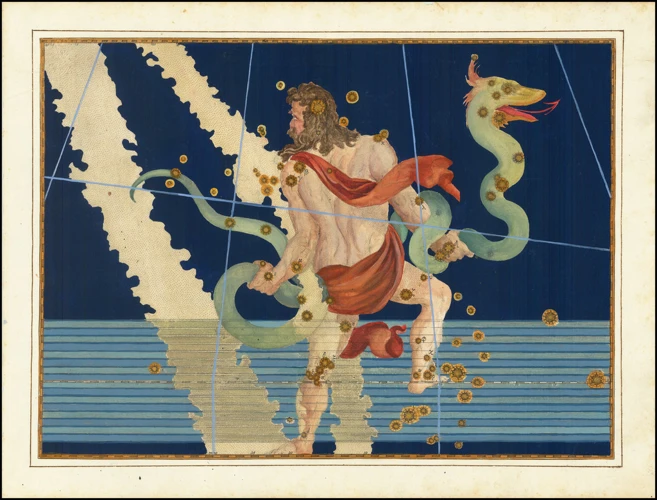
During the Renaissance period, Ophiuchus continued to inspire artists, finding its way into various art forms and visual representations. In astrological paintings of the time, Ophiuchus was often depicted as a central figure within the zodiac, alongside the traditional twelve signs. The inclusion of Ophiuchus in these paintings reflected a growing interest in astrology and the zodiac in Renaissance culture. Along with paintings, sculptures also showcased the influence of Ophiuchus. Sculptors sought to capture the enigmatic and powerful nature of the constellation, often using intricate details to depict the constellation itself or incorporating the symbolism of the serpent and staff associated with Ophiuchus. The Renaissance era marked a period of exploration, innovation, and an appreciation for the celestial world, making Ophiuchus a notable presence in the artistic works of the time.
1. Ophiuchus in Astrological Paintings
Astrological paintings have long been a popular medium for artists to explore celestial themes and the zodiac. Within this realm, Ophiuchus holds a unique place as a lesser-known, yet intriguing, constellation. In astrological paintings, Ophiuchus is often depicted as a human figure holding a serpent or a snake, symbolizing the Serpent Bearer. The presence of Ophiuchus in these paintings adds an extra layer of complexity and depth to astrological interpretations. Artists often use vibrant colors and intricate details to bring Ophiuchus to life, creating a visual representation of its significance in the zodiac. The inclusion of Ophiuchus in astrological paintings encourages viewers to question the traditional divisions of the zodiac and consider the influence of this enigmatic constellation. These paintings invite contemplation and exploration, challenging the boundaries of astrological interpretations and inspiring a deeper understanding of the celestial world.
2. Ophiuchus in Sculptures
Ophiuchus, the constellation of the Serpent Bearer, has also left its imprint in the world of sculpture throughout history. In ancient times, sculptures depicting Ophiuchus were often associated with the god Asclepius and the concept of healing. These sculptures showcased the figure of a man, holding a serpent or a staff entwined with a snake, representing the healing powers of Ophiuchus. One such notable example is the famous Statue of Asclepius at the Temple of Asclepius in Epidaurus, Greece. This impressive sculpture portrays a serene and noble Ophiuchus figure, emanating a sense of wisdom and healing. In Renaissance art, Ophiuchus continued to inspire sculptors, who sought to capture the grace and mystique of this constellation. Notable sculptures depicting Ophiuchus can be found in various locations, including the Vatican Museums, where the figure of Ophiuchus is portrayed alongside other zodiac symbols. These sculptures serve as a testament to the enduring influence of Ophiuchus in the realm of visual art, symbolizing the power of healing and the belief in the celestial forces that govern life and well-being.
Modern Interpretations of Ophiuchus
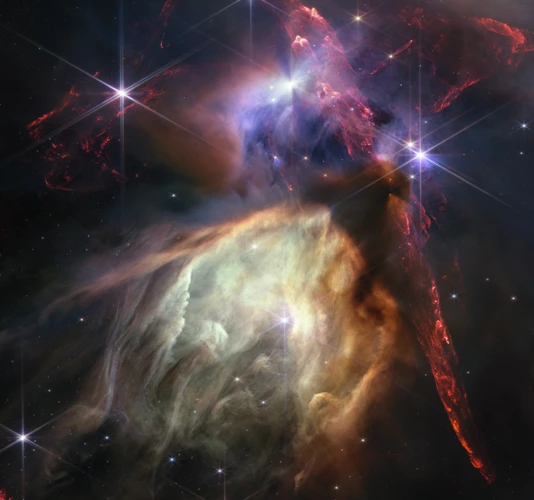
In the realm of modern art, Ophiuchus continues to inspire and intrigue artists with its mythical and symbolic nature. Contemporary artists have found innovative ways to incorporate Ophiuchus into their works, exploring themes of spirituality, astrology, and transformation. In contemporary art, Ophiuchus is often depicted as a cosmic figure, representing the connection between the earthly and celestial realms. Digital art, with its limitless possibilities, has provided a platform for artists to reimagine Ophiuchus in vibrant and abstract forms, experimenting with colors, shapes, and textures. The fusion of technology and art has allowed artists to push the boundaries of imagination and create immersive experiences for viewers. Ophiuchus also finds its place in astrology-inspired artworks, where it represents the 13th zodiac sign, challenging traditional notions and expanding horizons. Through diverse mediums and interpretations, modern artists continue to breathe new life into Ophiuchus, connecting with contemporary themes and captivating audiences with their unique visions.
1. Ophiuchus in Contemporary Art
Ophiuchus continues to inspire artists in contemporary times, with its mystical qualities and rich symbolism finding expression in various art forms. In contemporary art, Ophiuchus is often depicted as a powerful figure, representing the balance between the earthly and celestial realms. Artists explore the theme of healing and transformation through their interpretations of Ophiuchus, infusing their works with vibrant colors and intricate details. Paintings featuring Ophiuchus often showcase the figure surrounded by swirling serpents and celestial bodies, conveying a sense of cosmic energy and spiritual awakening. Sculptures depicting Ophiuchus illustrate the serpent bearer in dynamic poses, capturing the essence of strength and wisdom. The digital art realm embraces Ophiuchus as well, with artists using computer graphics and digital manipulation techniques to create mesmerizing visuals that push the boundaries of imagination. Ophiuchus in contemporary art serves as a reminder of our connection to the universe and the potential for personal growth and transformation.
2. Ophiuchus in Digital Art
Ophiuchus has found its way into the modern world of art through the medium of digital art. With the advancement of technology, artists have embraced digital tools to create breathtaking and imaginative representations of this celestial constellation. In digital art, Ophiuchus has been portrayed in various styles and contexts. Artists often utilize digital painting techniques to create vibrant and detailed illustrations of Ophiuchus, showcasing the intricate patterns of stars and the mythical figure associated with the constellation. Digital art also offers the flexibility to experiment with different textures, colors, and lighting effects, allowing artists to bring a new level of depth and dimension to their Ophiuchus-themed artworks. Additionally, digital artists have explored the potential of animation and motion graphics to breathe life into Ophiuchus. Through animations, Ophiuchus can come alive, with the serpent twisting and turning around the figure, creating mesmerizing visual spectacles. The versatility of digital art allows for endless possibilities in portraying Ophiuchus and capturing its allure in new and innovative ways.
The Symbolism of Ophiuchus in Art
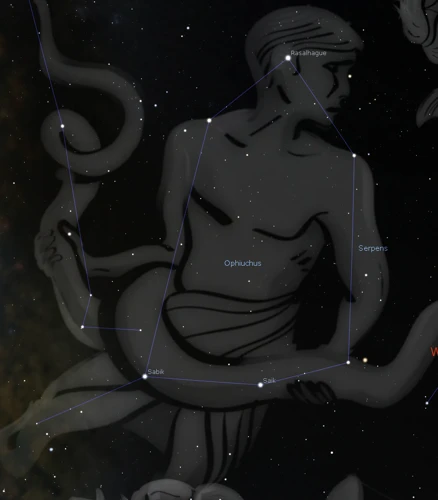
The symbolism of Ophiuchus in art is multifaceted and rich with meaning. One of the prominent themes associated with Ophiuchus is healing and medicine. In many artistic representations, Ophiuchus is portrayed as a healer, holding the serpent-entwined staff of Asclepius. This symbolizes the power of healing and the restoration of health. Ophiuchus is also often associated with wisdom and knowledge. In art, Ophiuchus is depicted as a figure of great wisdom, representing the pursuit of knowledge and the understanding of the mysteries of the universe. Additionally, Ophiuchus symbolizes transformation and renewal. The image of the serpent shedding its skin serves as a metaphor for personal growth and the ability to shed old habits and beliefs in order to transform oneself. Through art, Ophiuchus embodies these symbolic meanings, inspiring artists to explore themes of healing, wisdom, and transformation in their creative expressions.
1. Healing and Medicine
The symbolism of Ophiuchus in art revolves around its association with healing and medicine. In ancient representations, Ophiuchus is often depicted holding the Rod of Asclepius, a staff with a serpent wrapped around it. This symbol is widely recognized as a representation of healing and rejuvenation. The serpent, a potent symbol of transformation and renewal, represents the healing powers inherent in Ophiuchus. The serpent shedding its skin is symbolic of the process of renewal and rebirth. This motif can be seen in various ancient art forms, such as sculptures, where Ophiuchus is portrayed in a regenerative pose, with serpents intertwined around the figure. The presence of Ophiuchus in the context of healing and medicine suggests a belief in the power of these practices to bring about physical and spiritual well-being. The depiction of Ophiuchus in healing rituals and offerings speaks to the reverence and importance given to this constellation in ancient cultures. The portrayal of Ophiuchus as a healer in art serves as a reminder of the timeless pursuit of healing and the deep connection between humanity and the natural world.
2. Wisdom and Knowledge
Wisdom and knowledge are two qualities often associated with the constellation Ophiuchus in art. In various artistic representations, Ophiuchus is depicted as a figure of immense wisdom and deep understanding. This association stems from the mythology surrounding Ophiuchus, where the constellation is believed to represent the Greek figure of Asclepius, the god of medicine and healing. Asclepius was known for his extensive knowledge of herbal remedies and his ability to cure ailments. In artistic depictions, Ophiuchus is shown holding the Rod of Asclepius, a symbol of wisdom and healing power. Artists have used various mediums to portray Ophiuchus’ wisdom, from ancient sculptures and paintings to contemporary digital art. The intricate details and careful craftsmanship in these artworks convey the importance of knowledge and the desire to seek wisdom. Additionally, Ophiuchus’ position in the night sky, positioned near the constellation Sagittarius and neighboring the constellation Scorpio, adds to its association with esoteric knowledge and the mysteries of the universe. Through art, Ophiuchus represents the timeless pursuit of wisdom and the value of knowledge in human culture.
3. Transformation and Renewal
3. Transformation and Renewal:
Transformation and renewal are powerful themes that are often associated with Ophiuchus in art. The constellation’s representation as the Serpent Bearer is closely tied to the concept of shedding old skin and undergoing a metamorphosis, symbolizing personal growth and transformation. In art, Ophiuchus is often depicted in dynamic and energetic poses, emphasizing the transformative journey of the human spirit. Artists have used various mediums to convey this idea, including paintings, sculptures, and digital art. Paintings may depict individuals in the midst of a transformative experience, with the serpent symbolizing the shedding of past limitations and embracing a new self. Sculptures may showcase Ophiuchus in a posture that conveys strength and renewal, inspiring viewers to embark on their own journeys of personal transformation. In the realm of digital art, artists employ vibrant colors and fluid forms to capture the essence of change and renewal. Through their creativity, artists have harnessed the symbolism of Ophiuchus to inspire viewers and evoke a sense of possibility, reminding us of the transformative power within ourselves.
Conclusion
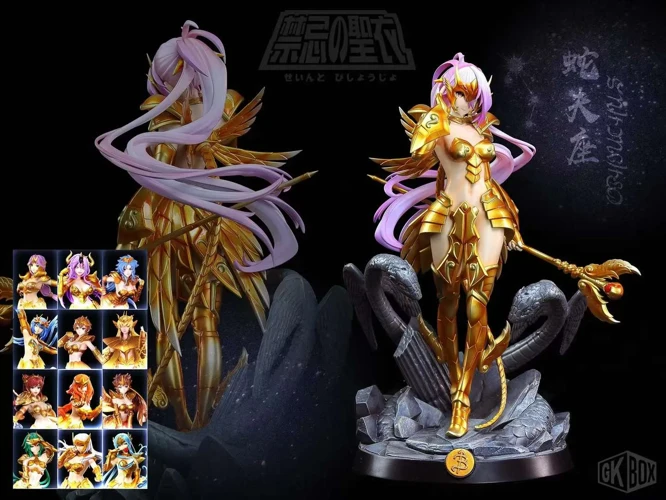
In conclusion, the role of Ophiuchus in art and visual representations is multi-faceted and enduring. From its ancient origins in mythology and art to its presence in Renaissance masterpieces and modern interpretations, Ophiuchus has maintained its allure and symbolism. The constellation’s association with healing and medicine has been a recurring theme throughout history, as seen in the depiction of the Rod of Asclepius and its connection to the god of healing, Asclepius. Ophiuchus also represents wisdom and knowledge, embodying the pursuit of understanding and enlightenment. Furthermore, Ophiuchus symbolizes transformation and renewal, capturing the essence of growth and change. Artists have found inspiration in these themes, using Ophiuchus as a means to convey these ideas through various artistic mediums. Whether it’s through ancient depictions, Renaissance artworks, or modern digital creations, Ophiuchus continues to fascinate and captivate both artists and audiences alike. Its celestial presence in the art world serves as a testament to the enduring power of mythology and symbolism.
Frequently Asked Questions

1. What is the significance of Ophiuchus in mythology?
Ophiuchus holds great significance in mythology as it is often associated with the Greek god of healing, Asclepius. Asclepius’ connection to Ophiuchus is showcased through the famous symbol of the serpent wrapped around a staff, known as the Rod of Asclepius. This symbol represents healing and medicine, emphasizing the importance of Ophiuchus in the realm of health and well-being.
2. How does Ophiuchus feature in ancient art?
Ophiuchus features prominently in ancient art, particularly in pottery, mosaics, and sculptures. Artists often depicted the serpent-bearing figure in various artistic forms, showcasing its connection to healing and rejuvenation. The serpent wrapped around a staff, symbolic of Ophiuchus, can be seen in many ancient artworks, emphasizing its significance in visual representations of that time.
3. Is Ophiuchus present in Renaissance art?
Yes, Ophiuchus made its mark in Renaissance art as well. It can be found in astrological paintings of that era, where artists explored celestial themes, including the zodiac signs and constellations. Ophiuchus also appeared in sculptures and other artistic mediums of the Renaissance period, further solidifying its presence in the art world.
4. How does Ophiuchus feature in contemporary art?
Ophiuchus continues to inspire contemporary artists, who incorporate it into their works in various ways. Whether through paintings, installations, or mixed media art, contemporary artists explore Ophiuchus’ symbolism and its connection to healing, wisdom, and transformation. Its presence in contemporary art reflects a continued fascination with this celestial figure.
5. What role does Ophiuchus play in digital art?
Ophiuchus has found its place in the realm of digital art as well. Digital artists often utilize modern technology and techniques to create visually stunning representations of Ophiuchus. From digital paintings to interactive installations, Ophiuchus takes on new life in the digital art world, showcasing its adaptability and ongoing relevance.
6. What is the symbolism behind Ophiuchus in art?
Ophiuchus holds various symbolic meanings in art. Firstly, it symbolizes healing and medicine, depicted through its connection to Asclepius and the Rod of Asclepius. Secondly, Ophiuchus represents wisdom and knowledge, as the serpent is often associated with ancient wisdom and mystical teachings. Lastly, Ophiuchus signifies transformation and renewal, as the shedding of a serpent’s skin symbolizes rebirth and growth.
7. How does Ophiuchus symbolize healing and medicine?
Ophiuchus is closely linked to healing and medicine due to its association with Asclepius, the Greek god of healing. The serpent wrapped around the staff, the Rod of Asclepius, is a universal symbol of healing and has become synonymous with the medical profession. Ophiuchus’ depiction in art often emphasizes its healing powers and the belief in the restoration of health and well-being.
8. Why is Ophiuchus associated with wisdom and knowledge?
The serpent, a key element of Ophiuchus’ symbolism, has been associated with wisdom and knowledge in various cultures throughout history. In art, Ophiuchus often embodies this connection, representing the acquisition and understanding of ancient wisdom and mystical teachings. The serpent’s ability to shed its skin and renew itself also symbolizes the continuous growth and deepening of knowledge.
9. How does Ophiuchus represent transformation and renewal in art?
Ophiuchus symbolizes transformation and renewal through the depiction of the serpent shedding its skin. This act represents the process of rebirth and growth, as the old is shed to make way for the new. Artists often use this symbolism to convey themes of personal growth, spiritual transformation, and the cyclical nature of life.
10. What is the overall impact of Ophiuchus in art history?
Ophiuchus has left a lasting impact on art history. From ancient representations in mythology and art to its presence in Renaissance masterpieces and modern digital creations, Ophiuchus has served as a source of inspiration and fascination for artists throughout the ages. Its symbolism of healing, wisdom, and transformation provides artists with a rich and versatile subject matter, allowing them to explore various themes and concepts in their work.
References
- Ophiuchus – The Serpent Bearer – Mystik Maze
- Ophiuchus Constellation (the Serpent Bearer)
- Ophiuchus Location, Mythology & Features
Frequently Asked Questions

1. Who is Ophiuchus in mythology?
Ophiuchus, also known as Serpentarius, is a figure from ancient Greek mythology. He is often depicted as a man holding a serpent, representing his association with snakes and healing.
2. What is the significance of Ophiuchus in astrology?
Ophiuchus is considered the 13th zodiac sign according to some astrologers. Its inclusion expands the traditional 12 zodiac signs, adding a new dimension to astrological interpretations.
3. How did Ophiuchus influence ancient art?
Ophiuchus played a significant role in ancient art, particularly in mythology-inspired paintings and sculptures. Artists often depicted him as a powerful healer or a wise figure with strong connections to serpents.
4. What are some famous artistic representations of Ophiuchus?
One famous artistic representation of Ophiuchus is the sculpture known as “Laocoon and His Sons.” Another well-known depiction is the painting “Asclepius” by Gustave Moreau.
5. How does Ophiuchus appear in Renaissance art?
In Renaissance art, Ophiuchus appears in astrological paintings and sculptures. He is often shown alongside the other zodiac signs, either in a separate panel or as part of a larger celestial scene.
6. What is the symbolism behind Ophiuchus in contemporary art?
In contemporary art, Ophiuchus is often associated with themes of healing, transformation, and spirituality. Artists may use his image to explore concepts of personal growth and renewal.
7. How is Ophiuchus portrayed in digital art?
In digital art, Ophiuchus can be depicted in various ways, from intricate illustrations to animated character designs. The flexibility of digital media allows artists to experiment with different interpretations and styles.
8. What does the serpent represent in Ophiuchus art?
The serpent is a prominent symbol in Ophiuchus art and represents healing and wisdom. It is often intertwined with Ophiuchus’ staff, known as the Rod of Asclepius, which is a universal symbol for medicine.
9. What emotions or ideas does Ophiuchus art evoke?
Ophiuchus art can evoke a sense of mystery, healing, and transformation. It may inspire viewers to reflect on their own journeys of growth and self-discovery.
10. Is Ophiuchus recognized in all art forms?
Ophiuchus is not recognized in all art forms, but its presence can be found in various artistic mediums, including paintings, sculptures, digital art, and even tattoos.







